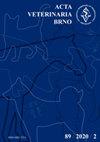Immunohistochemistry of nodular dermatofibrosis in a German Shepherd – a case report
IF 0.7
4区 农林科学
Q3 VETERINARY SCIENCES
引用次数: 0
Abstract
This case report describes nodular dermatofibrosis in an 11-year-old female dog of the German Shepherd breed. Previously, at the age of 6 years (initial stage), a sample from a tumorous nodule on her back was removed. Histological examination of the sample from this period showed hyperplasia of cells with a lobular structure. Immunohistochemistry staining demonstrated focal positivity to pancytokeratin. In the terminal stage (at 11 years of age), clinical examination revealed apathy, uncoordinated movement of the hind limbs, obstipation, anorexia and occasional vomiting with progressive weight loss. Skin inspection found multiple skin ulcerating tumorous lesions localized in the sacral region of the back and intercostally, partly fluctuating around the size 4 cm in diameter. Necropsy revealed an intraabdominal tumour localized among intestinal loops. Nodular lesions were found also in the lung parenchyma, on the dorsal surface of the epiglottis, in the myocardium, the cortex and the medulla of the kidneys, the adrenal gland, and in the intestinal wall. Histological analysis showed systemic production of fibrous nodules and formation of fibrous tissue with atrophy of parenchyma tissue. However, no connection between dermatofibrosis and adenocarcinoma of the kidney was found in this case, which was supplemented with pancytokeratin antibody. CD3 + lymphocytes were observed mainly in the zone of cell proliferation and in the interface towards the fibrous layer. Macrophages were seen mainly in the transitional zone between cellular and fibrous part. This indicated participation of monitored immunocompetent cells in fibroblast degradation.德国牧羊犬皮肤结节性纤维化的免疫组化1例报告
这个病例报告描述了结节性皮肤纤维化在一个11岁的母狗的德国牧羊犬品种。此前,在6岁(初期)时,从她背部的肿瘤结节中取出了样本。这一时期标本的组织学检查显示细胞增生,呈小叶结构。免疫组化染色显示全细胞角蛋白局灶性阳性。终末期(11岁),临床检查表现为情绪冷淡,后肢运动不协调,顽固,厌食,偶有呕吐,体重逐渐减轻。皮肤检查发现背部骶骨区及肋间多发皮肤溃疡性肿瘤灶,部分波动直径约4cm。尸检显示腹内肿瘤局限于肠袢。肺实质、会厌背表面、心肌、肾皮质、肾髓质、肾上腺、肠壁均可见结节状病变。组织学分析显示纤维结节的系统性产生和纤维组织的形成伴实质组织的萎缩。然而,在补充了泛细胞角蛋白抗体的病例中,未发现皮肤纤维化与肾腺癌之间的联系。CD3 +淋巴细胞主要分布在细胞增殖区和纤维层交界面。巨噬细胞主要分布在细胞和纤维部分之间的过渡区。这表明受监测的免疫活性细胞参与了成纤维细胞的降解。
本文章由计算机程序翻译,如有差异,请以英文原文为准。
求助全文
约1分钟内获得全文
求助全文
来源期刊

Acta Veterinaria Brno
农林科学-兽医学
CiteScore
1.00
自引率
33.30%
发文量
36
审稿时长
18-36 weeks
期刊介绍:
ACTA VETERINARIA BRNO is a scientific journal of the University of Veterinary and Pharmaceutical Sciences in Brno, Czech Republic.
The scientific journal Acta Veterinaria Brno is dedicated to the publication of original research findings and clinical observations in veterinary and biomedical sciences. Original scientific research articles reporting new and substantial contribution to veterinary science and original methods that have not been submitted for publication elsewhere are considered for publication. A written statement to this effect should accompany the manuscript, along with approval for publication by the author´s head of department. The authors bear full responsibility for the contents of their contribution. Book reviews are published, too.
 求助内容:
求助内容: 应助结果提醒方式:
应助结果提醒方式:


